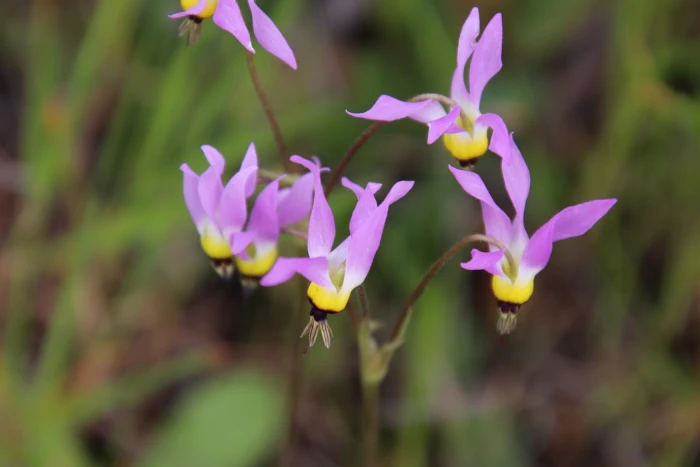Padre’s Shootingstar
(Dodecatheon clevelandii)
Padre’s Shootingstar (Dodecatheon clevelandii)
/
/

Millie Basden
CC BY 4.0
Image By:
Millie Basden
Recorded By:
Copyright:
CC BY 4.0
Copyright Notice:
Photo by: Millie Basden | License Type: CC BY 4.0 | License URL: http://creativecommons.org/licenses/by/4.0/ | Rights Holder: Millie Basden | Publisher: iNaturalist | Date Created: 2019-03-08T12:28:37-08:00 |

















































Estimated Native Range
Climate Requirements for Essen, Germany
| This Plant | Your Site | Plant Suitability for Your Location | ||
|---|---|---|---|---|
| • Precipitation | 5" - 54" | 36" | Aquatic | Aquatic |
| • High Temp. | 68°F - 102°F | 75°F | Your summer temperatures are normal for this plant. | Excellent |
| • Low Temp. | 20°F - 52°F | 33°F | Your winter temperatures are normal for this plant | Excellent |
This plant may not grow well at your location - your precipitation is too high.
Summary
Dodecatheon clevelandii, commonly known as Padre’s Shootingstar, is a spring deciduous perennial herb that is native to a variety of habitats including open woodlands, grasslands, and chaparral regions in California and Baja California. It typically grows to a height of 12 inches (30 centimeters) with basal clumps of oblong-lanceolate leaves that can reach up to 40 centimeters in length. The flowers are quite showy, with reflexed petals in shades of magenta, deep lavender, or white, and a prominent yellow or orange central stamen cluster. They bloom in the spring, nodding on slender stems up to a foot tall. After blooming, the plant dies back to the ground as the dry season progresses.
Padre’s Shootingstar is appreciated for its unique and striking flowers, which add a splash of color to spring gardens. It is suitable for wildflower gardens, rock gardens, and borders, and is often used in native plant landscaping to attract pollinators. This plant prefers well-drained soils and can tolerate a range of moisture conditions, though it does best with regular watering during the growing season. It can thrive in both full sun and part shade, making it versatile for various garden settings. While generally low-maintenance, it can be susceptible to root rot if overwatered or planted in poorly drained soils. It is not known for being invasive when grown outside its native range.CC BY-SA 4.0
Padre’s Shootingstar is appreciated for its unique and striking flowers, which add a splash of color to spring gardens. It is suitable for wildflower gardens, rock gardens, and borders, and is often used in native plant landscaping to attract pollinators. This plant prefers well-drained soils and can tolerate a range of moisture conditions, though it does best with regular watering during the growing season. It can thrive in both full sun and part shade, making it versatile for various garden settings. While generally low-maintenance, it can be susceptible to root rot if overwatered or planted in poorly drained soils. It is not known for being invasive when grown outside its native range.CC BY-SA 4.0
Plant Description
- Plant Type: Herb
- Height: 0.3-0.5 feet
- Width: 0.3-0.5 feet
- Growth Rate: Moderate
- Flower Color: Purple, Pink, Yellow
- Flowering Season: Spring
- Leaf Retention: Deciduous
Growth Requirements
- Sun: Full Sun, Part Shade
- Water: Medium
- Drainage: Slow, Medium
Common Uses
Bank Stabilization, Bee Garden, Butterfly Garden, Fragrant, Low Maintenance, Showy Flowers
Natural Habitat
native to a variety of habitats including open woodlands, grasslands, and chaparral regions in California and Baja California
Other Names
Common Names:
Scientific Names: Dodecatheon clevelandii
GBIF Accepted Name: Dodecatheon clevelandii Greene